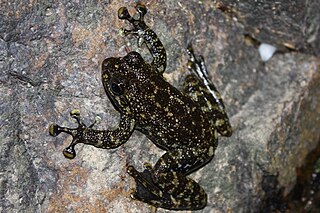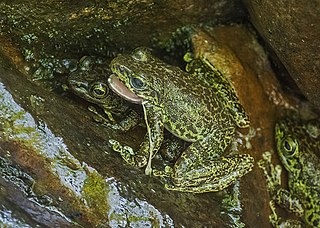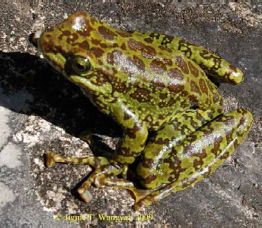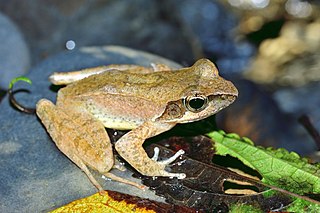
Hong Kong cascade frog or Hong Kong torrent frog is a species of true frog from southern coastal China, once thought to be endemic to Hong Kong. Their eggs are laid on rock faces in the splash zones of cascades. In Hong Kong, it is a protected species under Wild Animals Protection Ordinance Cap 170.

Amolops formosus, also known as Assam sucker frog, beautiful stream frog, Assam cascade frog, or hill stream frog, is a species of frog found in high gradient streams of northern India, northern Bangladesh, and Nepal, possibly also Bhutan, although these records may represent confusion between Amolops himalayanus and this species; the latest available IUCN assessment from 2004 treats A. himalayanus as a synonym of A. formosus.

Amolops marmoratus is a species of ranid frog found in Asia. Its common names include marbled sucker frog, marbled cascade frog, Pegu torrent frog, and many others. The taxonomic status of many populations formerly assigned to this species is uncertain.
Amolops monticola is a species of frog in the family Ranidae, the "true frogs". It is found in the Northeast India, eastern Nepal, and western China, although there is some uncertainty regarding the Chinese records. It probably also occurs in the intervening Bhutan. Common names mountain sucker frog, mountain stream frog, mountain torrent frog, and mountain cascade frog have been coined for it.
Amolops viridimaculatus, also known as green-spotted torrent frog, Dahaoping sucker frog, and Dahaoping cascade frog, is a species of frog found in Yunnan, China, northern Vietnam, northern Myanmar, and Nagaland, Northeast India; it is also expected to occur in northern Laos.
Amolops bellulus is a species of frog in the family Ranidae that is endemic to the Gaoligong Mountains. It is only known from the area of its type locality in Nujiang Lisu Autonomous Prefecture in Yunnan, China, but it is expected to occur in the adjacent Myanmarian part of the mountains. Amolops bellulus lives in and near fast-flowing mountain streams. Its status is insufficiently known.

Amolops chunganensis is a species of frog in the family Ranidae. Its type locality, Kuatun village in Wuyishan, Fujian. It is endemic to central, southern and eastern China where it has a wide but scattered distribution ; records from Vietnam probably refer to Amolops mengyangensis.
Amolops jinjiangensis is a species of frog in the family Ranidae. It is endemic to China where it is found in Yunnan and Sichuan provinces. Amolops jinjiangensis is a common species inhabiting hill streams inside forests. It is threatened by habitat loss.

Amolops larutensis is a species of frog in the family Ranidae that is found in the Malay Peninsula from southernmost Thailand to Malaysia; records further north probably represent A. panhai.
Amolops lifanensis is a species of frog in the family Ranidae that is endemic to central Sichuan, China. It is a common species within its small range, living in and along streams in forests. It is locally threatened by dam construction.

Amolops mantzorum, commonly known as the Sichuan torrent frog or Kangting sucker frog, is a species of frog in the family Ranidae. It is found in Gansu, Sichuan, and Yunnan Provinces of China. It has recently been reported also from Bhutan.
Amolops medogensis is a species of frog in the family Ranidae, the "true frogs". It is endemic to Mêdog County in southeastern Tibet. Its range might extend into the adjacent Arunachal Pradesh, India. Common name Medog torrent frog has been proposed for it.
Amolops nepalicus is a species of frog in the family Ranidae. It is endemic to Nepal and is only known from two localities in the Sankhuwasabha District. Common names Nepal sucker frog and Nepal cascade frog have been proposed for it.

Amolops ricketti is a species of frog in the family Ranidae that is found in southern and eastern China and northern and central montane Vietnam.

Amolops spinapectoralis is a species of frog in the family Ranidae, the "true frogs". It is at present only known from a few locations in central Vietnam—that is, it is endemic to Vietnam—but it is likely to be found more widely in the Vietnamese Central Highlands as well as in the adjacent southeastern Laos and northeastern Cambodia. The specific name spinapectoralis is derived from Latin spina for "thorn" and pectoralis for "of the breast" and refers to the pectoral spines in adult males. Common name spinyback torrent frog has been coined for it.
Amolops tuberodepressus is a species of frog in the family Ranidae. It is endemic to Yunnan, China and known from Wuliang and Ailao Mountains in Jingdong County. Once suspected to be synonym of Amolops mantzorum, its validity was confirmed with molecular methods in 2014.
Amolops mengyangensis is a species of frog in the family Ranidae. It is known with certainty only from its type locality, the eponymous Mengyang in Xishuangbanna Dai Autonomous Prefecture, southern Yunnan province of China. However, if Amolops daorum is its junior synonym, distribution of Amolops mengyangensis would be considerably wider, including the vicinity of Sa Pa in northern Vietnam near the Chinese border, Hong Kong, and Houaphanh Province in eastern Laos, and presumably also including the intervening areas.
Amolops daorum is a species of frog in the family Ranidae. It is known from its type locality in the vicinity of Sa Pa in northern Vietnam near the Chinese border, Hong Kong, and Houaphanh Province in eastern Laos; presumably it also occurs the intervening areas. The Hong Kong record is considered suspicious, however.

The common green frog is a frog species of in the true frog family Ranidae; some sources still use the old name Rana erythraea. It lives in Southeast Asia and is also known as green paddy frog, red-eared frog or leaf frog. The last name, however, commonly refers to the Neotropical tree frogs which make up the subfamily Phyllomedusinae. These are not closely related to H. erythraea, belonging to family Hylidae instead.

Rana sauteri is a species of true frog endemic to Taiwan. It inhabits low-altitude hill forests and the associated streams. It is an endangered species threatened by habitat loss due to agriculture and infrastructure development. Common names recorded for Rana sauteri include Kanshirei Village frog, Taiwan groove-toed frog, Sauter's brown frog, and Taiwan pseudotorrent frog.










